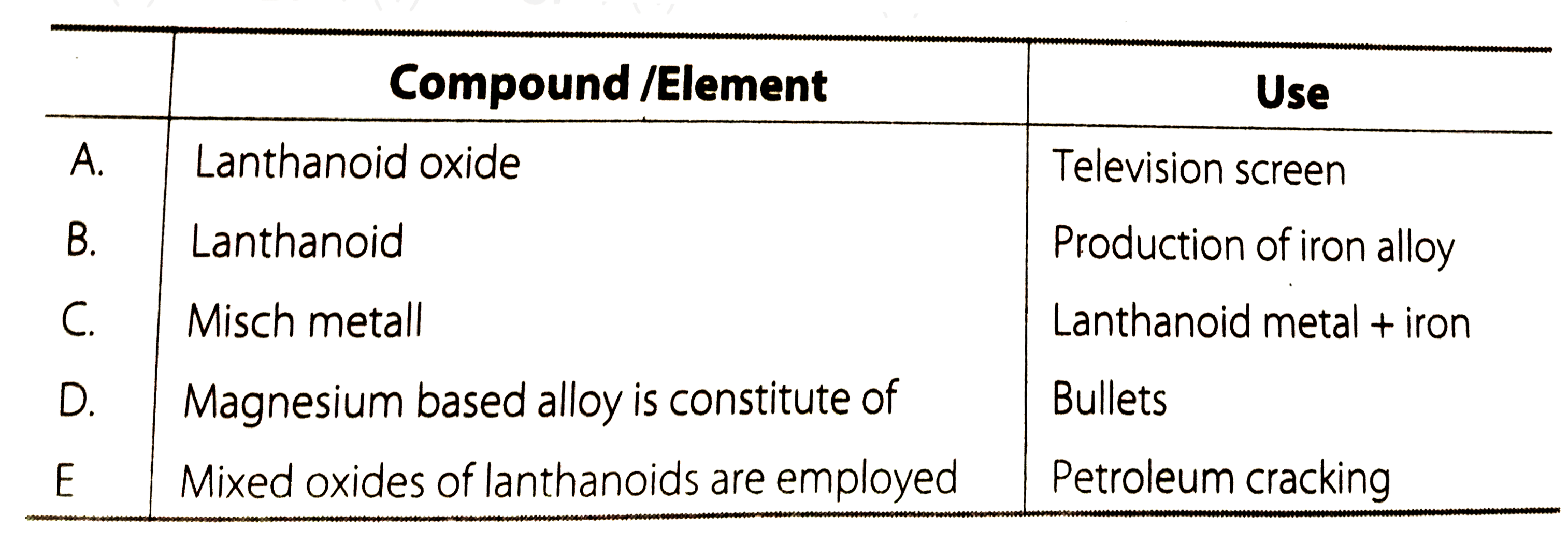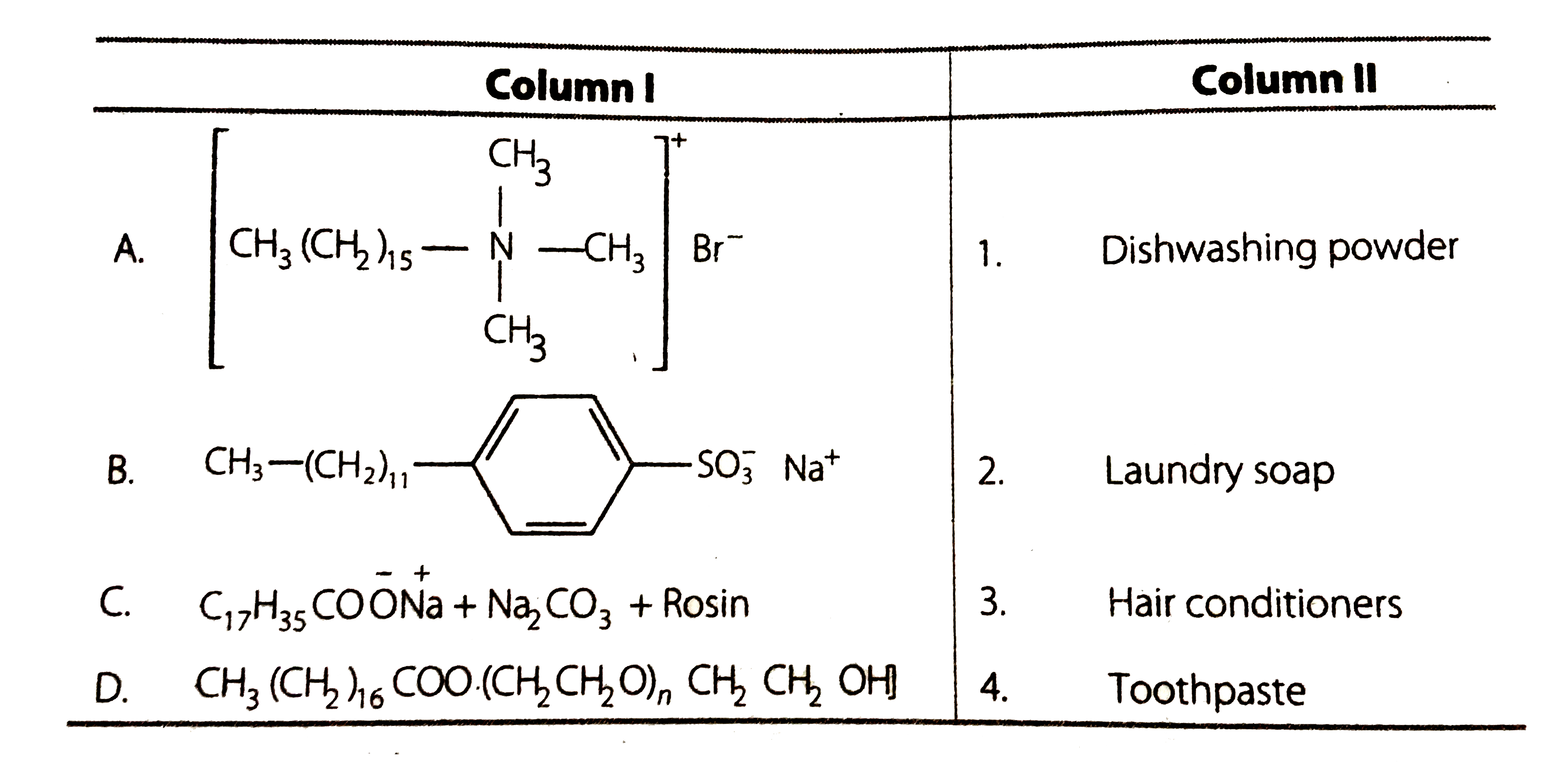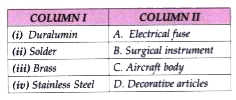Match the species given in Column I with properties given in Column II
Column-IColumn-IIA.Diborane1.Used as a flux for soldering metalsB.Gallium2.Crystalline form of silicaC.Borax3.Banana bondsD.Aluminossilicate4.Low melting, high boiling, useful for measuring high temperaturesE.Quartz5.Used as catalyst in petrochemical industries
To match the species given in Column I with the properties given in Column II, we will analyze each species and its corresponding property step by step.
1. Diborane (A):
- Diborane has the formula B2H6.
- It is known for having "banana bonds" in its structure, which are characteristic of the bonding between boron atoms and hydrogen.
- Match: A → 3 (Banana bonds).
2. Gallium (B):
- Gallium is a metal that has a melting point of about 30°C and a boiling point of approximately 2400°C.
- Due to this wide range of liquid state, it is useful for high-temperature thermometry.
- Match: B → 4 (Low melting, high boiling, useful for measuring high temperatures).
3. Borax (C):
- Borax is chemically represented as Na2B4O7.
- It is commonly used as a flux in soldering metals.
- Match: C → 1 (Used as a flux for soldering metals).
4. Aluminosilicate (D):
- Aluminosilicates are used as catalysts in petrochemical industries.
- Match: D → 5 (Used as a catalyst in petrochemical industries).
5. Quartz (E):
- Quartz is a crystalline form of silica.
- It is also known for its piezoelectric properties, but the primary property we need to match is that it is a crystalline form of silica.
- Match: E → 2 (Crystalline form of silica).
Final Matches:
- A → 3 (Banana bonds)
- B → 4 (Low melting, high boiling, useful for measuring high temperatures)
- C → 1 (Used as a flux for soldering metals)
- D → 5 (Used as a catalyst in petrochemical industries)
- E → 2 (Crystalline form of silica)
- Diborane has the formula B2H6.
- It is known for having "banana bonds" in its structure, which are characteristic of the bonding between boron atoms and hydrogen.
- Match: A → 3 (Banana bonds).
- Gallium is a metal that has a melting point of about 30°C and a boiling point of approximately 2400°C.
- Due to this wide range of liquid state, it is useful for high-temperature thermometry.
- Match: B → 4 (Low melting, high boiling, useful for measuring high temperatures).
- Borax is chemically represented as Na2B4O7.
- It is commonly used as a flux in soldering metals.
- Match: C → 1 (Used as a flux for soldering metals).
- Aluminosilicates are used as catalysts in petrochemical industries.
- Match: D → 5 (Used as a catalyst in petrochemical industries).
- Quartz is a crystalline form of silica.
- It is also known for its piezoelectric properties, but the primary property we need to match is that it is a crystalline form of silica.
- Match: E → 2 (Crystalline form of silica).
- A → 3 (Banana bonds)
- B → 4 (Low melting, high boiling, useful for measuring high temperatures)
- C → 1 (Used as a flux for soldering metals)
- D → 5 (Used as a catalyst in petrochemical industries)
- E → 2 (Crystalline form of silica)
Topper's Solved these Questions
- BOOK - NCERT EXEMPLAR ENGLISHCHAPTER - THE P-BLOCK ELEMENTSEXERCISE - Assertion and Reason2videos
THE P-BLOCK ELEMENTS
- BOOK - NCERT EXEMPLAR ENGLISHCHAPTER - THE P-BLOCK ELEMENTSEXERCISE - Long Answer9videos
THE P-BLOCK ELEMENTS
- BOOK - NCERT EXEMPLAR ENGLISHCHAPTER - THE P-BLOCK ELEMENTSEXERCISE - Short Answer14videos
THE P-BLOCK ELEMENTS
- BOOK - NCERT EXEMPLAR ENGLISHCHAPTER - STRUCTURE OF ATOMEXERCISE - All Questions55videos
STRUCTURE OF ATOM
- BOOK - NCERT EXEMPLAR ENGLISHCHAPTER - THE S-BLOCK ELEMENTS EXERCISE - Long Answer Type Questions8videos
THE S-BLOCK ELEMENTS
Similar Questions
Match the compounds/elements given in Column I with uses given in Column II.
 View Solution
View SolutionMatch the alloys given in column I with the uses given in column II.
View SolutionMatch the detergrents given in Column I with their uses in Column II.
 View Solution
View SolutionMatch the alloys given in column I to the uses given in column II.
 View Solution
View SolutionMatch the items given in Column 1 with examples give in Column II.
Column IColumn II(a)Hydrogen bond(i)C(b)Resonance(ii)LiF(c)Ionic solid(iii)H2(d)Covalent solid(iv)HF(v)O3View SolutionMatch the types of colloidal systems given in Column I with the name given in Column II.
Column IColumn IIA.Solid in liquid1.FoamB.Liquid in solid 2.SolC.Liquid in liquid 3.GelD.Gas in liquid4.EmulsionView SolutionMatch the elements given in column (I) with the most appropriate expected values given in column (II)
Column IColumn IIElementElectronegative valuesA.F(p)3.5B.O(q)3.0C.N(r)4.0D.C(s)2.5View SolutionMatch the compounds given in Column I with their uses mentioned in Column II.
ColumnIColumnIIA.CaCO31.Densitry ornamental workB.Ca(OH)22.Manufacture of sodium carbonate from caustic sodaC.CaO3.Manufacure of high quality paperD.CaSO44.Used in white washingView SolutionMatch the hydrocarbons in column I with the boiling points given in column II.
Column IColumn II(i). n-Pentane(a). 282.5 K(ii).iso-Pentane(b). 309 K(iii). neo-Pentane(c). 301 KView SolutionMatch the items in Column-I with Column-II and choose the correct alternative
Column-IColumn-IIa.Fasciculated storage roots1.Tinosporab.Pneumatophores2.Heritierac.Haustoria3.Asparagusd.Stilt-roots4.Viscume.Assimilatory roots5.ScrewpineView Solution

